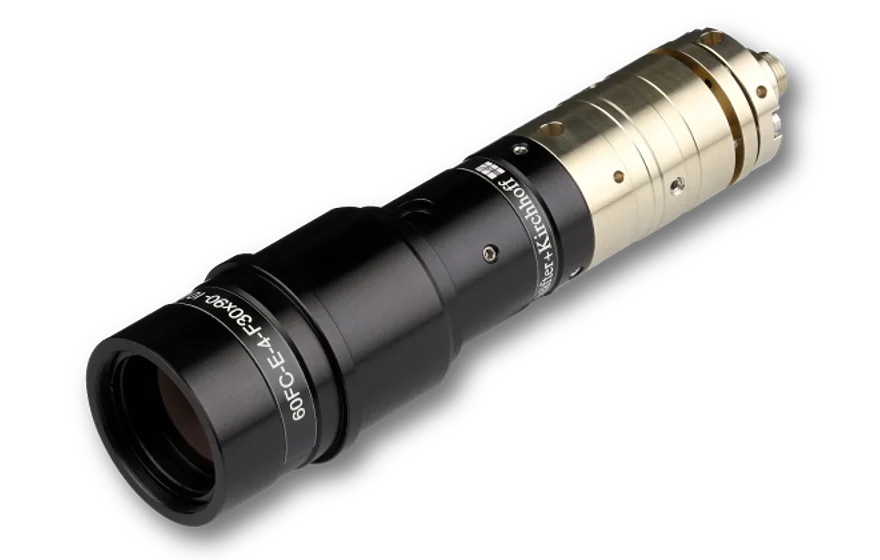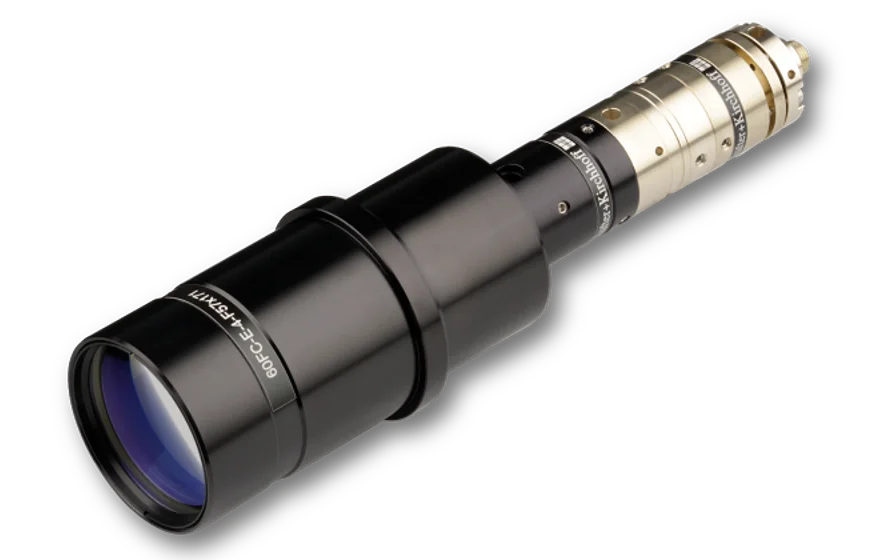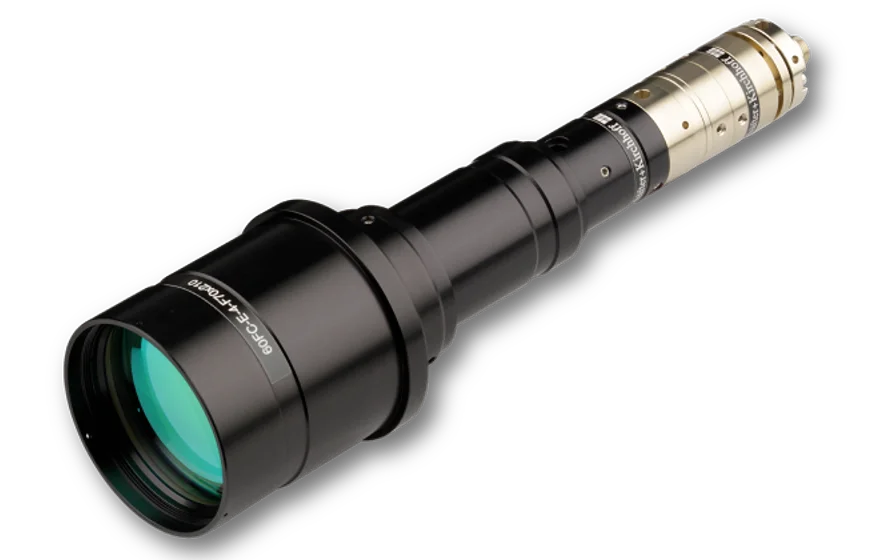Features
- Aspect ratio up to 1:3
- Polarization circularly polarized
- Gaussian intensity profiles along both elliptical axes
- Rugged and compact design
- A front-fitting for attachments, such as a diaphragm
for an ellipical beam cross-section and with a circular state of polarization



In some quantum optical experiments, collimated laser beams with an elliptical cross-section and a circular state of polarization are used, for example as cooling beams in two dimensional magneto-optical traps (2D-MOTs) or in mirror MOTs. They are suitable for polarization-maintaining fiber cables leading to collimated beams with a Gaussian intensity profile and an elliptical beam cross section with an axis ratio of up to 1:3.
An optics for each application
A large variety of optical designs allows that the optimum focal length and the aspect ratio you need can be selected for each application. All lenses are AR-coated.
Optical design
The radiation of the fiber is collimated to a beam with a diameter in the range Ø 1 - 4 mm.
In this collimated beam a low-order quarter-wave plate changes the state of polarization from linear to left-handed or to right-handed circular. An adjacent anamorphic beam shaping optics transforms the circular beam into a beam with an elliptical cross section. Finally the beam is expanded to the desired diameter.
Adjustment of focus
All fiber collimators of seris 60FC-E-Q are aligned for the specified wavelength.
In case of need you can change the distance between fiber end-face and the first collimating optics by means of an eccentric key. The lens does not rotate when adjusting the focus fo both cases. The final focus setting is locked by means of two radially arranged clamping screws. Additionally attachment optics can be mounted to the front of the collimator.
Optimum lens performance
The angled polish of connectors of type APC is considered by a pre-angled mechanical coupling axis that compensates the beam deflection and you can use the lens centrically. This minimizes aberrations simply resulting from a non-ideal beam path through the lens.
Connector Type
The fiber collimator can be equipped with FC PC (wide key*), FC APC (wide key*), SMA-905 (F-SMA), ST or LSA (compatible with fiber connectors type DIN, AVIO and AVIM) receptacles. In case of FC or LSA with a spring loaded ferrule the fiber coupler has an additional grub screw to increase pointing stability.
Material
The fiber collimators are made of nickel silver and black anodized aluminum.
Mounting
The collimators series 60FC-E-Q all posses a flange for low-strain mounting e.g. using the clamp collars series CC.
Option
Besides these series 60FC-E-Q fiber collimators there is the series 60FC-E. These fiber collimators generate a collimated beam with elliptical cross section and a linear state of polarization.

| Order Code | Aspect Ratio | Eff. Focal Length | Design Wavelength | Quarter-Wave Plate | Clear Aperture | For Connector Type |
|---|---|---|---|---|---|---|
| 60FC-E-Q461-4-F30x90 | 1 : 3 | 30 x 90 mm | 461nm | low-order | 20 mm | FC APC |
| 60FC-E-Q761-4-F30x90 | 1 : 3 | 30 x 90 mm | 741 nm | low-order | 20 mm | FC APC |
| 60FC-E-Q421-4-F30x90 | 1 : 3 | 30 x 90 mm | 421 nm | low-order | 20 mm | FC APC |
| 60FC-E-Q671-4-F30x90 | 1 : 3 | 30 x 90 mm | 671 nm | low-order | 20 mm | FC APC |
| 60FC-E-Q780-4-F57x114 | 1 : 2 | 57 x 114 mm | 780 nm | low-order | 29 mm | FC APC |
| 60FC-E-Q780-4-F57x171 | 1 : 3 | 57 x 171 mm | 780 nm | low-order | 29 mm | FC APC |
| 60FC-E-Q780-4-F70x210 | 1 : 3 | 70 x 210 mm | 780 nm | low-order | 48 mm | FC APC |
| 60FC-E-Q852-4-F70x210 | 1 : 3 | 70 x 210 mm | 852 nm | low-order | 48 mm | FC APC |
| 60FC-E-Q780-4-F90x180 | 1 : 2 | 90 x 180 mm | 780 nm | low-order | 40 mm | FC APC |
The transmission of an optical component mainly depends on its internal transmission and the anti-reflective (AR) coating.
For short wavelengths (UV) or longer wavelengths (IR), the internal or glass transmission of the optics plays a key role, as it can significantly reduce the amount of light passing through them. Unless otherwise specified, the internal transmission of our optics is greater than 96%. For optics with wavelength ranges with an internal transmission of less than 96%, the relevant wavelength range is specified in the "Technical Data" section.
Details about the AR coating (reflectivity over wavelength) can be found in the AR coating plot and details about the internal glass transmission (transmission over wavelength) can be found in the transmission plot. Both plots can be found in the "Downloads" section of the respective product webpage.
Attaching a fiber cable to a Schäfter+Kirchhoff fiber collimator is done in 5 simple steps.
The right-hand orientation rule provides a high reproducibility in mode field position and angle. This is important for attaching and reattaching polarization-maintaining fibers reproducibly.
When the ferrule tip is safely located in the inner cylinder of the receptacle, align the connector to the receptacle axis and carefully introduce the connector into the fiber coupler.
Then, orient the connector key in a way that it is pressed gently onto the right-hand side of the receptacle notch. Hence, "right-hand rule".
Bothe the tightened grub screw and the "right-hand orientation rule" for the connector, ensure a high reproducibility in mode field position and angle, which is especially important for attaching and reattaching PM fibers reproducibly.
Yes, you can attach a narrow key fiber cable to a "wide key" collimator- without any problem. Simply adhere to the "right-hand orientation rule".
Generally, with any FC PC or FC APC type connector there is a freeplay when inserting the fiber into the fiber coupler. The free play in between the connector ferrule and receptacle is only a few microns, but necessary for inserting the ferrule without force. There is a difference between the receptable and key width for wide key (2.14 mm) and narrow key (2.0 mm) fibers. If you follow the so-called "right-hand orientation rule" you can reproducibly attach and reattach even PM fibers with narrow key receptacle to fiber couplers with wide key receptacle without difficulty.
"Right-hand orientation rule":
When the ferrule tip is safely located in the inner cylinder of the receptacle, align the connector to the receptacle axis and carefully introduce the connector into the fiber coupler. Then, orient the connector key in a way that it is pressed gently onto the right-hand side of the receptacle notch. The tightened grub screw and the "right-hand orientation rule" for the connector, ensure a high reproducibility in mode field position and angle, which is especially important for attaching and reattaching polarization-maintaining fibers reproducibly.
This downloads section only includes general downloads for the complete series.
Please access the individual product pages (using the product configurator, the product list, order options or the search button if you have a complete order code). Here you will find specific downloads including technical drawings or stepfiles.
Measurement tool for coupling into polarization-maintaining fiber cables
Polarization-maintaining fiber cables
| Lens Code | M30 | M35 | M40 | M60 | M60L | M75 | M100S |
| Focal length f' | 30.0 | 35.0 | 40.0 | 60.0 | 60.0 | 75.0 | 100 |
| Numerical Apperture NA | 0.23 | 0.16 | 0.21 | 0.14 | 0.2 | 0.16 | 0.12 |
| Clear apert. max. [mm] | 14 | 11.5 | 17 | 17 | 24 | 24 | 24 |
| Correction - achrom. | X | X | X | X | X | X | X |
| 390 - 670 nm | 33 | ||||||
| 400 - 700 nm | 01 | 01 | 01 | ||||
| 400 - 1000 nm | 24 | 24 | 24 | 24 | 24 | 24 | |
| 420 - 700 nm | 26 | 26 | 26 | 26 | 26 | 26 | |
| 450 - 700 nm | 04 | 04 | |||||
| 630 - 980 nm | 10 | ||||||
| 630 - 1080 nm | 54 | ||||||
| 650 - 1050 nm | 02 | 02 | 02 | ||||
| 750 - 1550 nm | 37 | 37 | 37 | 37 | 37 | 37 | |
| 980 - 1550 nm | 08 | ||||||
| 1050 - 1700 nm | 03 | ||||||
| Lens Code | M30 | M35 | M40 | M60 | M60L | M75 | M100S |
| Focal length f' | 30.0 | 35.0 | 40.0 | 60.0 | 60.0 | 75.0 | 100 |
| Numerical Apperture NA | 0.23 | 0.16 | 0.21 | 0.14 | 0.2 | 0.16 | 0.12 |
| Clear apert. max. [mm] | 14 | 11.5 | 17 | 17 | 24 | 24 | 24 |
| Correction - achrom. | X | X | X | X | X | X | X |